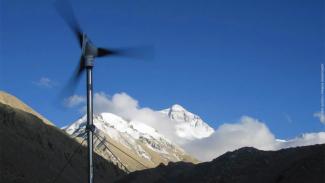WINDExchange Small Wind Guidebook
This guide from the U.S. Department of Energy provides up-to-date foundational knowledge on small wind system components, costs, maintenance, generation prediction, and term glossary. Visit the website

An official website of the United States government
Here's how you know
The .gov means it’s official.
Federal government websites often end in .gov or .mil. Before sharing sensitive information, make sure you’re on a federal government site.
The site is secure.
A lock () or https:// ensures that you are connecting to the official website and that any information you provide is encrypted and transmitted securely.
Wind turbine systems can yield lower electricity costs than photovoltaic (PV) generation systems despite their higher maintenance costs, but identifying a suitable wind site is significantly more complicated.
Wind turbines generate emissions-free electricity from a renewable energy resource. One advantage they have over solar power is their ability to generate electricity through the night. However, it is much more difficult to select a site for a wind turbine than a solar array. While extensive maps of solar resources exist and are extensively used in siting solar arrays, the same is not true of wind resources. Wind maps are less readily available and small topographical features at a site can have a significant impact on electricity generation at a clinic. It is recommended that wind speeds at a site be measured for at least one year before engineers can reliably predict the amount of electricity that can be produced at a potential site.
Wind turbines are sized according to the amount of power they will generate at a specific wind speed. The larger the turbine is, or the faster the wind blows, the more power it produces. Small wind turbines are available with capacities that range from a few hundred watts to 100 kW. The largest wind turbines can be multi-MW units. Due to the significant fixed overhead costs associated with siting a wind turbine, larger-sized wind turbines yield lower energy costs. Similar to photovoltaic (PV) systems, wind turbines must be connected to the grid or to a battery system to provide continuous power.
The difference in installation cost between large and small turbines is large due to the many factors. Larger turbines are generally placed on higher towers, accessing faster winds and producing more power. Wind turbines also have significant overhead costs that do not scale with turbine size (e.g. wind speed measurement at site.) These overhead costs will represent a significant fraction of the costs of installing a smaller turbine but will be a smaller fraction of a larger turbine, or a wind turbine farm. An average cost for small wind turbine systems (of less than 100 kW) is $8,300/kilowatt. The cost per watt decreases substantially as turbine size increases. An average cost for a large wind turbine system (more than 1 MW) is $2,900/kilowatt. The electricity needs of off-grid healthcare facilities are too low for them to consider large wind turbines.
The capital cost for small wind turbines is similar to that of PV systems, but wind turbine systems will generate roughly 50 percent more energy than a comparably sized PV system. If a healthcare facility is lucky enough to be located in a good wind location, it is a low-cost, off-grid energy source that should be considered. Solar-wind hybrid systems are also potential generation solutions for healthcare facilities to consider. The primary advantage of adding a wind turbine to a solar system is the reduced need for battery backup and the resulting cost savings.
Maintenance requirements for turbines are heavily dependent on local conditions and, due to the moving parts, are greater than for PV systems. Normally, a turbine should receive a maintenance check every three months. Necessary maintenance includes lubrication of the moving parts, checking bolts and electrical connections, checking supporting guy wires for proper tension, and examining components for corrosion. Rotor blades and bearings normally need replacement after about ten years. Small turbines (fewer than 10 kW) generally do not require a gearbox, which is a component that often requires attention in larger systems.
This guide from the U.S. Department of Energy provides up-to-date foundational knowledge on small wind system components, costs, maintenance, generation prediction, and term glossary. Visit the website
This guide from the U.S. Department of Energy explains how small wind electric systems are one of the most cost-effective home-based renewable energy systems—with zero emissions and pollution. Visit the website
